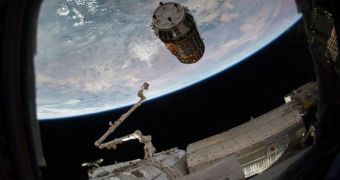On Tuesday, March 29, the H-II Transfer Vehicle (HTV-2) will be deorbited intentionally. The spacecraft will meet a fiery end, disintegrating in Earth's atmosphere, but not before conducting a series of experiments that will yield more insight into this destructive process.
The unmanned cargo capsule was detached from its docking berth on the International Space Station (ISS) on Sunday, January 27, and is currently orbiting the planet on a path that will ensure its destruction tomorrow.
Designed and built by the Japan Aerospace Exploration Agency (JAXA) and its contractors, the capsule launched earlier this year, delivering tons of supplies, space parts and experiments to the orbital lab.
It has since been loaded with thrash and other items astronauts in orbit no longer use. The spacecraft, called Kounotori 2, is currently prepared to burn up in the atmosphere. However, there are some things it needs to do before it's allowed to perish.
Installed on board the capsule is an advanced sensor, that will send mission controllers at the Tsukuba Space Center (TSC) details about the finer aspects of the deorbiting process. Some of the factors the sensor will track include spacecraft temperature, acceleration and rotational rates.
The instrument, called the Re-entry Breakup Recorder (REBR), is expected to provide interesting insight into the multitude of factors that combine to destroy the ship as it reenters the atmosphere.
“REBR is made possible by tiny little instruments, tiny sensors and tiny cell phone technology. It is basically a satellite phone with a heat shield,” explains expert William Ailor,” quoted by Space.
He is the director of the Center for Orbital and Reentry Debris Studies, at the El Segundo, California-based Aerospace Corporation. Ailor adds that a second sensor is placed on the Automated Transfer Vehicle (ATV) Johannes Kepler.
The capsule, the second the European Space Agency (ESA) built and sent to the ISS, is still docked to the station, but it too will be deorbited later this year in a similar manner to Kounotori 2.
“It's all automatic, totally self-contained. It does everything itself and detects when certain things are happening,” Ailor says of how the REBR sensors operate. HTV-2 flew to orbit with two such sensors, but one of them was subsequently moved to Johannes Kepler.
As the Japanese spacecraft breaks up in Earth's atmosphere, it will at one point release a capsule containing the REBR sensor, which will then go into free-fall for about five minutes.
During the descent, it will contact the Iridium satellite communications network, and upload all the readings it made during Kounotori 2's destruction onto the spacecraft. The data will then be downlinked to mission control for analysis.

 14 DAY TRIAL //
14 DAY TRIAL //